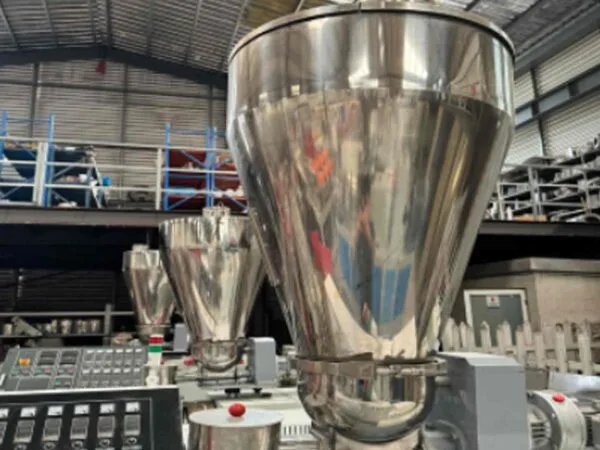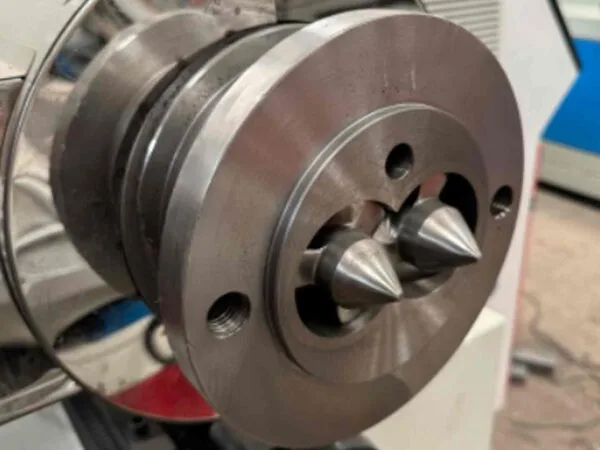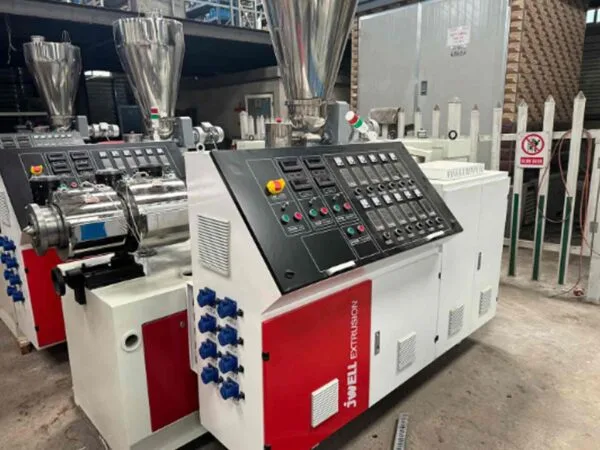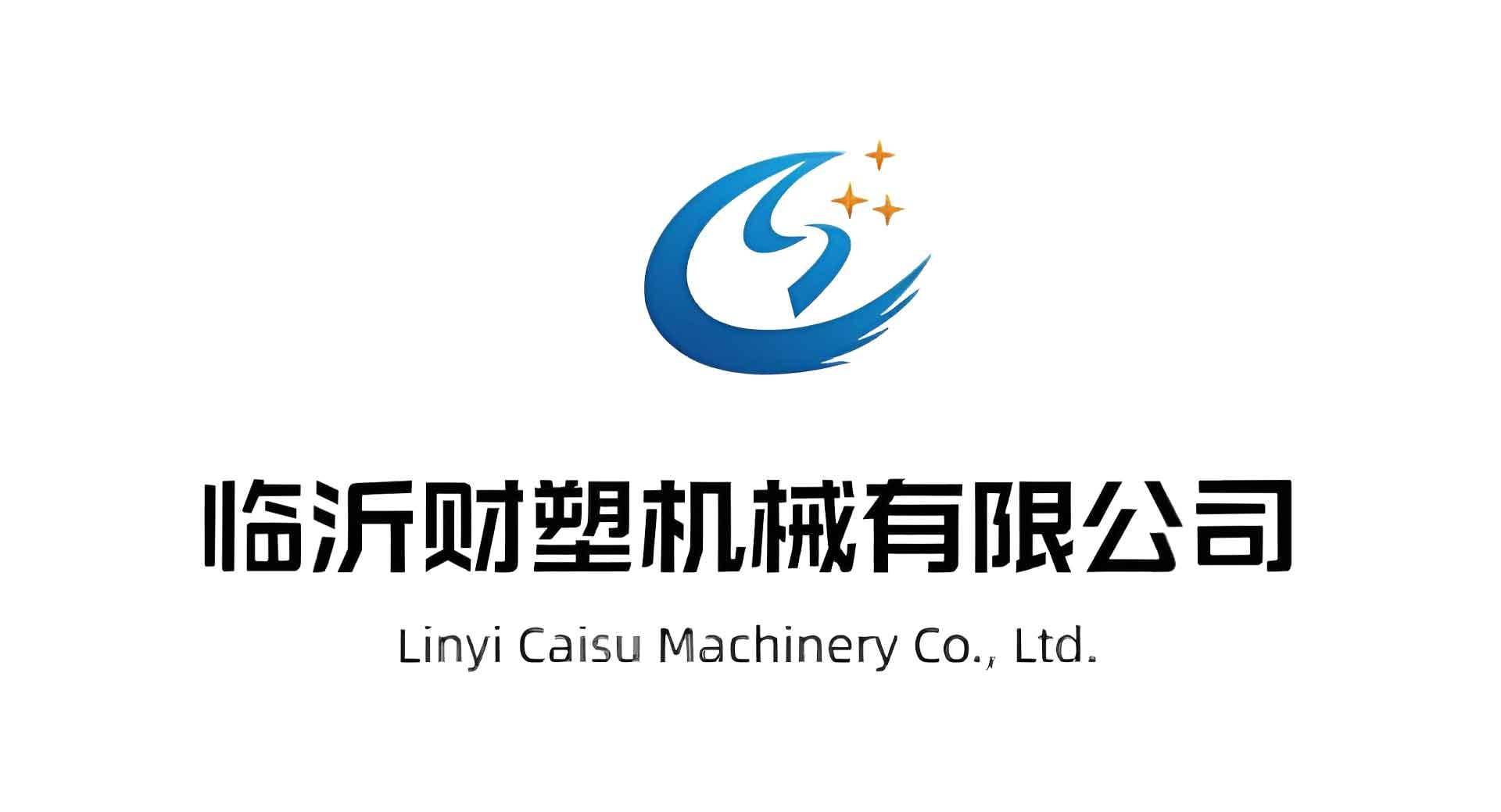Welcome to My Blog!
Before we dive into the content, I’d love for you to join me on my social media platforms where I share more insights, engage with the community, and post updates. Here’s how you can connect with me:
Facebook:https://www.facebook.com/profile.php?id=61567891941530
Now, let’s get started on our journey together. I hope you find the content here insightful, engaging, and valuable.
Caisu Machinery sells a variety of used plastic pipe production equipment. The products are of high quality and low price. Welcome to contact us for consultation and purchase. We will be happy to serve you.
Table of Contents
Introduction

Screw extrusion is a versatile and widely used manufacturing process that involves transforming raw materials into continuous profiles through the application of heat and pressure. This process is fundamental in various industries, including plastics, food processing, and pharmaceuticals. The efficiency, precision, and adaptability of screw extrusion machines make them indispensable tools for modern manufacturing.
In this comprehensive guide, we will explore the different types of screw extrusion machines, their key features, applications, and the factors that influence their selection.
Understanding Screw Extrusion Technology
The Basics of Screw Extrusion
Screw extrusion is a process where raw material, often in the form of pellets or powder, is fed into a heated barrel. A rotating screw inside the barrel pushes the material forward, applying heat and pressure to melt and homogenize it. The molten material is then forced through a die at the end of the barrel, shaping it into the desired profile. This continuous process allows for the production of long, uniform products with consistent properties.
Key Components of Screw Extrusion Machines
To understand the different types of screw extrusion machines, it is essential to familiarize yourself with their key components:
- Barrel: The main body of the extruder where the raw material is heated and melted.
- Screw: The rotating element inside the barrel that moves and mixes the material.
- Die: The component at the end of the barrel that shapes the molten material into the desired profile.
- Heating and Cooling Systems: These systems control the temperature inside the barrel to ensure proper melting and processing of the material.
- Drive System: Provides the mechanical power to rotate the screw.
The Role of Screw Design
The design of the screw is crucial in determining the efficiency and performance of the extrusion process. Screws can vary in length, diameter, and pitch, and can have different flight profiles and mixing elements. The choice of screw design depends on the specific requirements of the material being processed and the desired properties of the final product.
Types of Screw Extrusion Machines


Single-Screw Extrusion Machines
Overview and Applications
Single-screw extrusion machines are the most common type of extrusion equipment. They consist of a single rotating screw inside a heated barrel. The simplicity of their design makes them cost-effective and easy to maintain. Single-screw extruders are widely used in the plastics industry for applications such as pipe extrusion, sheet extrusion, and pelletizing.
Advantages and Limitations
- Advantages:
- Cost-Effective: Lower initial investment and maintenance costs compared to multi-screw extruders.
- Simplicity: Easier to operate and maintain due to fewer moving parts.
- Versatility: Suitable for a wide range of materials and applications.
- Limitations:
- Mixing Efficiency: Limited mixing capabilities compared to twin-screw extruders, which may affect the homogeneity of the material.
- Throughput: Generally lower throughput compared to twin-screw extruders, especially for high-viscosity materials.
Twin-Screw Extrusion Machines
Overview and Applications
Twin-screw extrusion machines feature two parallel screws that rotate either in the same direction (co-rotating) or in opposite directions (counter-rotating). These machines offer superior mixing and melting capabilities, making them ideal for processing complex materials and formulations. Twin-screw extruders are commonly used in the compounding of plastics, food processing, and pharmaceutical applications.
Advantages and Limitations
- Advantages:
- Enhanced Mixing: Superior mixing and melting capabilities, resulting in more uniform material properties.
- Higher Throughput: Capable of processing higher volumes of material compared to single-screw extruders.
- Flexibility: Can handle a wide range of materials and formulations, including those with high filler content.
- Limitations:
- Higher Cost: More expensive to purchase and maintain due to their complex design.
- Complexity: Requires more skilled operators and maintenance personnel.
Co-Rotating vs. Counter-Rotating Twin-Screw Extruders
Co-Rotating Twin-Screw Extruders
Co-rotating twin-screw extruders have screws that rotate in the same direction. This design promotes strong intermeshing and high shear mixing, making them ideal for applications that require thorough mixing and dispersion of additives.
- Applications: Compounding of plastics, food processing, and pharmaceuticals.
- Advantages: High mixing efficiency, excellent dispersion of additives, and high throughput.
- Limitations: Higher wear on screws and barrels due to high shear forces.
Counter-Rotating Twin-Screw Extruders
Counter-rotating twin-screw extruders have screws that rotate in opposite directions. This design reduces shear forces and promotes gentle mixing, making them suitable for processing heat-sensitive materials.
- Applications: Processing of thermally sensitive materials, such as certain food products and pharmaceuticals.
- Advantages: Reduced shear forces, gentle mixing, and lower energy consumption.
- Limitations: Lower mixing efficiency compared to co-rotating extruders.
Comparison Table: Types of Screw Extrusion Machines
| Feature/Aspect | Single-Screw Extruder | Co-Rotating Twin-Screw Extruder | Counter-Rotating Twin-Screw Extruder |
|---|---|---|---|
| Number of Screws | One | Two (same direction) | Two (opposite directions) |
| Mixing Efficiency | Moderate | High | Moderate |
| Throughput | Moderate to High | High | Moderate to High |
| Initial Cost | Low to Moderate | High | High |
| Maintenance Cost | Low to Moderate | High | High |
| Complexity | Low | High | High |
| Applications | Plastics, Pelletizing | Compounding, Food Processing | Thermally Sensitive Materials |
| Shear Forces | Moderate | High | Low |
| Energy Consumption | Moderate | High | Low |
| Material Versatility | Moderate | High | Moderate |
| Suitability for Additives | Limited | Excellent | Good |
Factors Influencing the Selection of Screw Extrusion Machines
Material Requirements
The type of material being processed is a critical factor in selecting the appropriate screw extrusion machine. Different materials have varying melting points, viscosities, and sensitivities to shear and temperature. For example, thermally sensitive materials may require counter-rotating twin-screw extruders to minimize degradation, while high-viscosity materials may benefit from the enhanced mixing capabilities of co-rotating twin-screw extruders.
Desired Product Properties
The desired properties of the final product also influence the choice of extrusion machine. If uniform dispersion of additives and high mixing efficiency are required, twin-screw extruders are generally preferred. On the other hand, if the application demands high throughput and cost-effectiveness, single-screw extruders may be more suitable.
Production Volume and Throughput
The production volume and throughput requirements of your manufacturing process play a significant role in determining the type of screw extrusion machine needed. Twin-screw extruders typically offer higher throughput capabilities, making them ideal for large-scale production. Single-screw extruders, while capable of handling moderate to high volumes, may not match the throughput of twin-screw machines for certain applications.
Budget Considerations
The initial investment and ongoing maintenance costs of screw extrusion machines vary significantly. Single-screw extruders are generally more cost-effective in terms of both purchase price and maintenance. Twin-screw extruders, particularly those with advanced features and capabilities, come with a higher price tag and require more specialized maintenance. Manufacturers must carefully balance their budget constraints with the performance requirements of their production process.
Space Availability
The physical footprint of the extrusion machine is another important consideration, especially for manufacturers with limited factory space. Single-screw extruders are typically more compact and easier to integrate into existing production lines. Twin-screw extruders, due to their more complex design, often require more space for installation and operation.
Practical Considerations for Operating Screw Extrusion Machines

Temperature Control
Precise temperature control is essential in screw extrusion to ensure proper melting and processing of the material. Both the barrel and the die should be equipped with heating and cooling systems to maintain optimal temperatures throughout the process. Temperature profiles can be adjusted based on the specific requirements of the material and the desired properties of the final product.
Screw Speed and Torque
The speed and torque of the screw significantly impact the extrusion process. Higher screw speeds can increase throughput and mixing efficiency but may also introduce higher shear forces, which can degrade heat-sensitive materials. Torque requirements vary depending on the material viscosity and the design of the screw. Modern extrusion machines often feature variable speed drives and high-torque motors to provide optimal performance across a range of operating conditions.
Die Design
The design of the die is crucial in determining the shape and dimensions of the final extruded product. Dies can be custom-designed to produce a wide variety of profiles, from simple shapes like pipes and sheets to more complex geometries. Proper die design requires careful consideration of material flow, pressure distribution, and cooling requirements to ensure consistent product quality.
Maintenance and Troubleshooting
Regular maintenance is essential to ensure the reliability and efficiency of screw extrusion machines. Common maintenance tasks include cleaning and inspecting the barrel and screw, checking the heating and cooling systems, and lubricating moving parts. Troubleshooting common issues such as material degradation, die blockages, and uneven product dimensions requires a thorough understanding of the extrusion process and the ability to identify and correct the root causes of problems.
Conclusion
Screw extrusion machines are essential tools in modern manufacturing, offering unparalleled versatility and precision for transforming raw materials into finished products. Understanding the different types of screw extrusion machines, their key features, and the factors that influence their selection is crucial for optimizing production processes and achieving desired product properties. Single-screw extruders provide cost-effective and versatile solutions for a wide range of applications, while twin-screw extruders offer superior mixing and throughput capabilities, making them ideal for more demanding processes.
If you need more information, please feel free to contact us.
FAQ
What is the main difference between single-screw and twin-screw extruders?
The main difference between single-screw and twin-screw extruders lies in the number of screws and their rotation. Single-screw extruders have one rotating screw, while twin-screw extruders have two screws that can either rotate in the same direction (co-rotating) or opposite directions (counter-rotating). Twin-screw extruders offer superior mixing and melting capabilities, making them suitable for complex formulations and higher throughput applications.
How do I choose the right screw extrusion machine for my application?
Choosing the right screw extrusion machine depends on several factors, including the type of material being processed, desired product properties, production volume, budget constraints, and space availability. Single-screw extruders are often preferred for cost-effective and versatile solutions, while twin-screw extruders are ideal for applications requiring high mixing efficiency and throughput. Consultation with an experienced extrusion engineer or equipment supplier can help determine the best machine for your specific needs.
What are the advantages of twin-screw extruders over single-screw extruders?
Twin-screw extruders offer several advantages over single-screw extruders, including:
Enhanced Mixing: Superior mixing and melting capabilities, resulting in more uniform material properties.
Higher Throughput: Capable of processing higher volumes of material.
Flexibility: Can handle a wider range of materials and formulations, including those with high filler content.
Improved Dispersion: Better dispersion of additives and colorants.
Are twin-screw extruders more expensive than single-screw extruders?
Yes, twin-screw extruders are generally more expensive than single-screw extruders due to their more complex design and advanced features. The initial purchase price, as well as maintenance costs, are typically higher for twin-screw extruders. However, their enhanced capabilities can justify the investment, especially for applications requiring high mixing efficiency and throughput.
What are the common applications of single-screw extruders?
Single-screw extruders are widely used in the plastics industry for applications such as pipe extrusion, sheet extrusion, and pelletizing. They are also used in the manufacturing of various consumer products, including packaging materials and automotive components. Their versatility and cost-effectiveness make them suitable for a broad range of applications.





